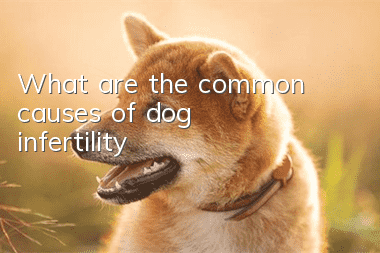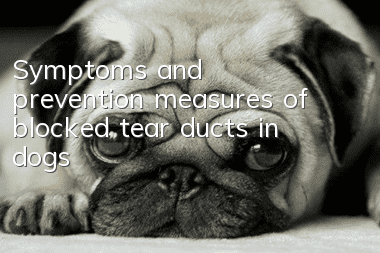What are the common causes of dog infertility?

The pregnancy rate of female dogs is affected by various factors, including feeding and management, whether the body is healthy, and whether the male dog is normal. If a female dog is still unable to conceive after multiple breedings and changing male dogs, then there is probably a problem with the female dog itself.
The situation of infertility in female dogs is more complicated and requires multiple examinations to rule out the problem.
1. Causes of infertility in female dogs:
■1. Improper feeding and management: If the owner is overly pampered and simply feeds too much protein, fat and sugar for a long time, coupled with a lack of exercise, the female dog will be too obese, with fat deposition in the ovary and fatty degeneration of the follicular epithelium. Affected animals are not in estrus, or are in estrus but are infertile. Even if they become pregnant, they have a higher chance of miscarriage.
■2. Malnutrition: Common dog food is monotonous, inferior, or lacks essential amino acids, minerals, and vitamins. Specifically: vitamin A deficiency can cause degeneration of epithelial cells, egg cells, and follicle epithelial cells in the endometrium. Follicle atresia or cyst formation; Vitamin E deficiency can cause pregnancy interruption, stillbirth or hidden miscarriage (fetus is absorbed); B vitamin deficiency can weaken the uterine contraction function, destroy egg cell production and ovulation, and cause the mother to suffer from long-term No estrus; vitamin D deficiency can cause mineral (especially calcium and phosphorus) metabolism disorders in the body, which can indirectly cause infertility.
■3. Abnormal development of sexual organs: such as: underdevelopment of reproductive organs or lack of reproductive ability (infant disease) when reaching breeding age; hermaphroditism, that is, having both male and female gonads; abnormalities of the reproductive tract, such as slender cervix and uterine horns, vaginal or The vulva is too narrow or closed (unable to mate), etc.
■4. Disease-related infertility: such as cystic endometrial hyperplasia, pyometra syndrome, metritis, vaginitis, ovarian cysts, ovarian tumors, uterine and vaginal tumors, brucellosis, toxoplasmosis, leptozoa Spiral Nuo disease, etc.
■5. Reproductive technical infertility: Mainly due to poor artificial insemination technology and problems with semen preservation, which makes it lose its activity and naturally cannot impregnate the female dog.
■6. Environmental factors, sudden changes in temperature, sunshine, etc. can also cause infertility.
2. Treatment of infertility in female dogs:
Generally speaking, the causes of infertility in female dogs are complicated, which makes diagnosis difficult. It is easy to see that the key to treatment is correct diagnosis and identification of the cause. Diagnosis requires both detailed questioning and systematic examination. The consultation should include asking about age, parity, medical history, dietary conditions (source, quality, ingredients, quantity, etc.), mating status and male dog status, etc. Infertility should be treated sooner rather than later. Treatment includes general treatment and targeted treatment.
■1. General treatment refers to intensive feedingNutritional management, feeding regular full-price diets, giving necessary additives, strengthening exercise, etc.; targeted treatment refers to timely treatment of primary diseases, such as diseases of reproductive organs, etc.
■2. In addition, hormone therapy is a relatively effective method for treating infertility in female dogs. The hormones that can be used include trisynthetic hormones, prostaglandins, maternal serum gonadotropin, human chorionic gonadotropin, progesterone, and estrogen. Hormones etc. However, you must consider when choosing and prescribe the medicine carefully to avoid causing discomfort to your dog.
- When raising a pet dog, how to find a suitable space for it at home?
- Why can’t pets be bathed with human shampoo? And what about using their special shampoo?
- Things you need to pay attention to after your dog is pregnant, otherwise the consequences will be disastrous!
- How should you choose food for your pet?
- How to train your dog to refuse food from unknown sources
- Don’t teach them the wrong commands again! These basic password training must be mastered in dog training!
- Is it normal for dogs to be sleepy after minor injections?
- Is the American Bully suitable for home breeding? What kind of dog breed is it?
- Pregnant dogs must pay attention to these diets, otherwise the consequences will be disastrous!
- Why do dog vaccinations fail?



